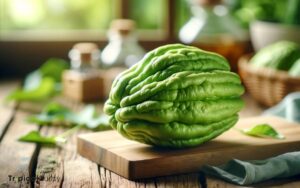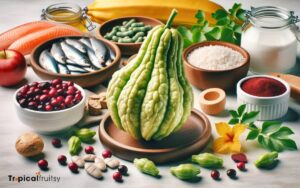Is Chayote a Root Crop? Digging Deep!
Chayote, scientifically known as Sechium edule, is not classified as a root crop. It is a fruit-bearing perennial plant that belongs to the gourd family, Cucurbitaceae, and is often used in culinary practices similar to vegetables.
Root crops are plants that store nutrients primarily in their roots, which are harvested and consumed.
Examples of root crops include:
Chayote, however, produces an edible fruit that grows above ground on a vine. Its growth habit is more akin to other members of the gourd family, such as cucumbers and melons.
Chayote offers diverse culinary uses and is a nutritious addition to a variety of dishes, not as a root but as a versatile fruit.

Key Takeaway
Understanding Chayote Classification
Chayote, scientifically known as Sechium edule, is classified as a perennial vine in the gourd family Cucurbitaceae, rather than a root crop.
This distinction is crucial for accurate botanical categorization and understanding the plant’s growth habit and reproductive strategies.
Chayote exhibits a growth pattern typical of other cucurbits, with sprawling stems that bear tendrils, facilitating climbing. It develops a tuberous root, yet this feature does not define its classification.
The chayote fruit, the part most commonly consumed, is a firm, pear-shaped structure that houses a single, large seed.
Its propagation is primarily through the planting of this seed-bearing fruit rather than through root division or tuber planting, which is characteristic of true root crops like potatoes and yams.
The Botanical Profile of Chayote
How does the chayote plant develop and what are its key botanical characteristics?
The chayote (Sechium edule) is a perennial climbing vine that belongs to the Cucurbitaceae family, which includes cucumbers, melons, and squashes. It is characterized by its method of propagation, growth habit, and fruit development.
- Propagation: Chayote plants are typically propagated through seed or vegetatively by planting the whole fruit, which contains a single, large, flattened seed.
- Vines: The plant develops extensive vines that can reach several meters in length, requiring support structures to facilitate vertical growth.
- Leaves: Its leaves are heart-shaped, with prominent veins and a glossy surface, providing a lush green appearance.
- Fruit: The fruit itself is pear-shaped, with a single, large pit, and has a green, wrinkled exterior when mature.
This botanical profile informs us that the chayote is not a root crop but rather a fruit-bearing vine.
Chayote Growth Habits Explained
Understanding the growth habits of the chayote plant is essential, as it develops through extensive vine systems that can stretch to lengths of several meters, requiring sturdy support for optimal fruit production.
The chayote, scientifically known as Sechium edule, is a perennial vine that climbs aggressively using tendrils, which facilitate its spread and anchoring to structures and vegetation.
The plant’s ability to grow rapidly is due to its vigorous root system, which anchors the vine and absorbs nutrients and water efficiently.
| Aspect of Growth | Description |
|---|---|
| Vine Length | Can reach over 15 meters |
| Support Requirements | Needs trellising for fruit bearing |
| Root System | Tubers with high regenerative capacity |
Common Misconceptions About Chayote
One common misconception is that chayote is a root crop, whereas it is actually the fruit of a vigorous climbing vine.
In addressing this confusion, it is essential to dispel a few other myths associated with this versatile plant:
- Chayote is often thought to be flavorless, yet it possesses a subtle, slightly sweet taste that absorbs accompanying flavors well.
- People sometimes believe chayote requires tropical conditions to thrive; however, it can grow in a variety of climates.
- There is a notion that chayote plants are annuals, while they are perennial in warmer regions.
- The idea that chayote is nutritionally void is incorrect; it is rich in vitamins and minerals.
These clarifications help reshape the understanding of chayote, paving the way to explore the culinary uses and benefits of this unique fruit.
Culinary Uses and Benefits of Chayote
In the realm of culinary versatility, chayote shines as a nutritious ingredient that can be prepared in myriad ways, from raw applications to cooked dishes.
This gourd, scientifically known as Sechium edule, is not a root crop but a fruit that delivers a mild flavor and a crisp texture, making it an excellent addition to a variety of recipes.
When consumed, chayote offers a range of health benefits due to its rich content of vitamins, minerals, and fiber.
| Preparation Method | Culinary Application |
|---|---|
| Raw | Salads, slaws |
| Steamed | Side dishes, fillings |
| Sautéed | Stir-fries, toppings |
| Baked | Casseroles, gratins |
Analyzing the nutritional profile of chayote reveals its low-calorie count, coupled with an absence of saturated fats and cholesterol, underscoring its suitability for heart-healthy diets and weight management.
Conclusion
Chayote, scientifically classified as Sechium edule, is not a root crop but a fruit-bearing vine of the gourd family.
Its growth habit involves producing edible fruits along its tendrils, which contradicts the typical characteristics of root vegetables.
Often misunderstood, chayote’s culinary versatility and nutritional benefits are nonetheless embraced globally.
Its consumption contributes to dietary diversity, offering a rich blend of vitamins, minerals, and fiber, while its cultivation supports agricultural sustainability.






